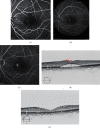Subthreshold Micropulse Treatment Laser versus Half-Dose Photo Dynamic Therapy for the Chronic Central Serous Chorioretinopathy with Parafoveal or Subfoveal Leakage STML versus PDT for Treatment of Chronic CSC
- PMID: 35814483
- PMCID: PMC9262565
- DOI: 10.1155/2022/3627903
Subthreshold Micropulse Treatment Laser versus Half-Dose Photo Dynamic Therapy for the Chronic Central Serous Chorioretinopathy with Parafoveal or Subfoveal Leakage STML versus PDT for Treatment of Chronic CSC
Abstract
Purpose: The study aimed to compare the efficacy and safety outcomes of a subthreshold micropulse treatment laser (SMTL) versus half-dose photodynamic therapy (PDT) for treatment of chronic central serous chorioretinopathy (cCSC) with parafoveal or subfoveal leakage to persistent subretinal fluid.
Methods: One hundred and forty-eight patients (148 eyes) with persistent cCSC were enrolled in this retrospective study and treated with SMTL or half-dose PDT. All patients were diagnosed according to clinical characteristics and findings on multimodal imaging. The medical records including patients with a minimum follow-up period of 3 months were reviewed. The patients were divided into two groups according to the application of the SMTL or PDT. The group of the SMTL or PDT was also divided into two subgroups according to parafoveal or subfoveal leakage. The primary outcomes included best-corrected visual acuity (BCVA) and central retinal thickness (CRT) before and 1, 2, and 3 months after treatment. The repeat treatment and resolution of subretinal fluid were also collected.
Results: Seventy-nine patients (79 eyes) treated with half-dose PDT and 69 Patients (69 eyes) treated with the STML were included. The mean age was 44.20 ± 7.42 years and 80% were male. No significant difference in age, gender, baseline logMAR BCVA or CRT between the half-dose PDT group and the SMTL group (P=0.201; 0.051) can be defined. The BCVA of the SMTL group improved at 1, 2, and 3 months after treatment, while that of the half-dose PDT group improved like the SMTL group. There were no significant differences between the SMTL and the PDT group at 1, 2, and 3 months (P=0.723; 0.139; 0.896). The CRT for the SMTL group decreased at 1, 2, and 3 months after treatment, while that of the half-dose PDT group changed like the SMTL group. However, there were significant differences between the SMTL group and the PDT group at 1and 3 months (P=0.010; 0.009). 13/69 (18.84%) and 9/79 (11.39%) patients underwent treatment at least twice in the SMTL and half-dose PDT group, respectively, and achieved resolution of SRF after treatment. The results of subgroups analysis showed no significant differences between the logMAR BCVA of the SMTL and PDT group which were divided into parafoveal and subfoveal leakage groups after treatment, but significant difference in CRT between subgroups can be found after treatment at 1and 3 months (P=0.003; 0.04).
Conclusions: The SMTL can be an effective candidate for the treatment of persistent cCSC where leakage occurred at parafoveal or subfoveal and improvement of logMAR BCVA, but half-dose PDT has been more effective for resolution of SRF.
Copyright © 2022 Qingshan Chen et al.
Conflict of interest statement
The authors declare that they have no conflicts of interest.
Figures






Similar articles
-
Comparative efficacy of half-dose and one-third-dose photodynamic therapy in chronic central serous chorioretinopathy: a retrospective study.Int J Retina Vitreous. 2025 Mar 18;11(1):32. doi: 10.1186/s40942-025-00657-6. Int J Retina Vitreous. 2025. PMID: 40102960 Free PMC article.
-
Long-term follow-up of chronic central serous chorioretinopathy after successful treatment with photodynamic therapy or micropulse laser.Acta Ophthalmol. 2021 Nov;99(7):805-811. doi: 10.1111/aos.14775. Epub 2021 Feb 10. Acta Ophthalmol. 2021. PMID: 33565230 Free PMC article. Clinical Trial.
-
One-year results of half-dose versus one-third-dose photodynamic therapy in chronic or recurrent central serous chorioretinopathy.BMC Ophthalmol. 2021 Jan 12;21(1):30. doi: 10.1186/s12886-020-01796-0. BMC Ophthalmol. 2021. PMID: 33430812 Free PMC article.
-
Therapeutic interventions for chronic central serous chorioretinopathy: a comprehensive assessment of systematic reviews.Int J Retina Vitreous. 2025 Mar 23;11(1):34. doi: 10.1186/s40942-025-00660-x. Int J Retina Vitreous. 2025. PMID: 40122856 Free PMC article. Review.
-
System review and meta-analysis on photodynamic therapy in central serous chorioretinopathy.Acta Ophthalmol. 2014 Dec;92(8):e594-601. doi: 10.1111/aos.12482. Epub 2014 Jul 13. Acta Ophthalmol. 2014. PMID: 25042260 Review.
Cited by
-
[Treatment of central serous chorioretinopathy in comparison-Micropulse laser versus photodynamic therapy].Ophthalmologie. 2025 Mar;122(3):186-195. doi: 10.1007/s00347-025-02183-0. Epub 2025 Feb 7. Ophthalmologie. 2025. PMID: 39920292 Review. German.
-
Bilateral Focal Choroidal Excavation and Central Serous Chorioretinopathy Coexisting in a Male Patient.Case Rep Ophthalmol Med. 2024 Mar 26;2024:5519361. doi: 10.1155/2024/5519361. eCollection 2024. Case Rep Ophthalmol Med. 2024. PMID: 38566845 Free PMC article.
-
Comparative efficacy of subthreshold micropulse laser versus conventional laser therapy in central serous chorioretinopathy.Lasers Med Sci. 2025 May 17;40(1):225. doi: 10.1007/s10103-025-04473-0. Lasers Med Sci. 2025. PMID: 40381063 Free PMC article.
-
Influence of combined eplerenone, aflibercept and nepafenac therapy on central serous chorioretinopathy.Int J Ophthalmol. 2025 Jun 18;18(6):1064-1070. doi: 10.18240/ijo.2025.06.12. eCollection 2025. Int J Ophthalmol. 2025. PMID: 40534795 Free PMC article.
-
Evaluating Photodynamic Therapy vs. Subthreshold Micropulse Laser for Central Serous Chorioretinopathy: A Retrospective Study.Klin Monbl Augenheilkd. 2025 Apr;242(4):405-412. doi: 10.1055/a-2542-4969. Epub 2025 Apr 16. Klin Monbl Augenheilkd. 2025. PMID: 40239673 Free PMC article.
References
LinkOut - more resources
Full Text Sources
Research Materials
Miscellaneous

